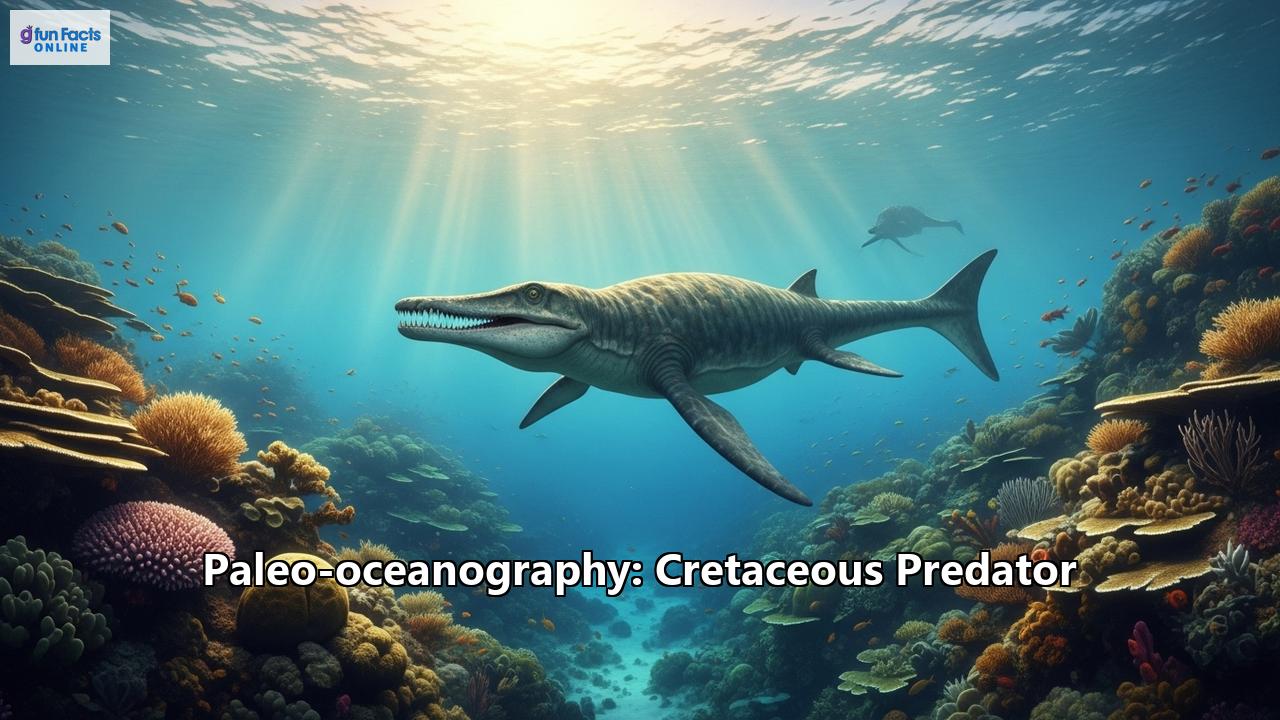Spanning from approximately 145 to 66 million years ago, the Cretaceous period was a time of dramatic global change, characterized by a warm climate and high sea levels that inundated continents, creating vast shallow inland seas. These ancient oceans teemed with life, setting the stage for the evolution of some of the most formidable predators ever to roam the Earth's waters. The breakup of the supercontinent Pangaea was well underway, leading to the formation of new oceans and seaways that would become the hunting grounds for these magnificent creatures.
A World of Water: The Cretaceous Marine Landscape
Two of the most significant marine environments of the Cretaceous were the Tethys Ocean and the Western Interior Seaway. The Tethys was a vast, warm, and tropical ocean that separated the ancient continents of Laurasia and Gondwana. It was a hub of biodiversity, dotted with islands and shallow seas that fostered the evolution of unique ecosystems. The remnants of the Tethys can be found today in the mountain ranges of the Alps, Himalayas, and the basins of the Mediterranean, Black, and Caspian Seas.
Stretching from the Gulf of Mexico to the Arctic Ocean, the Western Interior Seaway was a massive inland sea that effectively split North America into two landmasses: Laramidia to the west and Appalachia to the east. This shallow sea, at its greatest extent, was over 2,000 miles long, 600 miles wide, and up to 2,500 feet deep. Its warm, shallow waters were home to a plethora of marine life, making it a prime location for an array of predators. The periodic anoxic conditions on the seafloor of the seaway led to excellent preservation of fossils, providing a remarkable window into this ancient marine world.
The Reign of the Marine Reptiles
The Cretaceous oceans were dominated by a spectacular diversity of marine reptiles, highly adapted for an aquatic existence.
Mosasaurs: The Great Marine LizardsAppearing later in the Cretaceous, mosasaurs quickly rose to become the dominant marine predators. These were not dinosaurs, but rather a group of large, aquatic lizards closely related to modern monitor lizards. With their elongated bodies, powerful tails, and massive jaws filled with sharp, conical teeth, mosasaurs were formidable hunters. Some species, like the iconic Mosasaurus, could reach lengths of up to 60 feet, making them apex predators capable of taking on a wide range of prey.
Plesiosaurs: Long-Necks and Powerful JawsPlesiosaurs were another prominent group of marine reptiles, characterized by their broad, flat bodies, four powerful flippers, and, in many species, extraordinarily long necks. These long-necked plesiosaurs likely fed on smaller fish and invertebrates. In contrast, the pliosaurs, a type of plesiosaur with short necks and massive skulls, were apex predators. Some pliosaurs possessed jaws that were over two meters long, a testament to their predatory prowess.
Ichthyosaurs: The Fish-LizardsWhile their dominance waned by the mid-Cretaceous, ichthyosaurs were still present in the earlier part of the period. These reptiles were remarkably fish-shaped, a classic example of convergent evolution. With their streamlined bodies and powerful tails, they were fast and agile swimmers, preying on fish and squid-like belemnites.
The Fierce Fish and Voracious Sharks
The marine reptiles were not the only predators in the Cretaceous seas. The oceans were also home to a variety of large and fearsome fish and sharks.
**Xiphactinus: The Bulldozer Fish*
One of the most impressive bony fish of the Cretaceous was Xiphactinus, a massive predator that could grow to be over 15 feet long. Its powerful body and large, fang-like teeth made it a fearsome hunter. The famous "fish-within-a-fish" fossil, which shows a Xiphactinus that died after swallowing a large, 6-foot-long fish, provides a dramatic glimpse into the voracious appetite of this Cretaceous predator.
Cretaceous Sharks: An Ancient Lineage of Apex PredatorsSharks also played a significant role in the Cretaceous marine food web. Species like Cretoxyrhina, sometimes called the "Ginsu shark," were formidable predators that rivaled mosasaurs in their hunting abilities. With their torpedo-shaped bodies and razor-sharp teeth, they were adept at hunting a variety of prey. Another notable shark was the giant shellfish-eating Ptychodus mortoni*, which could reach lengths of over 30 feet.
A Mid-Cretaceous Shift: A Changing of the Guard
The middle of the Cretaceous period witnessed a significant turnover in marine predator populations. The once-dominant ichthyosaurs and pliosaurs largely disappeared from the fossil record. This extinction event coincided with a period of intense climate volatility and oceanic anoxia, a time when the oceans experienced a depletion of oxygen. These environmental changes restructured marine ecosystems, paving the way for the rise of new dominant predators like mosasaurs and new groups of sharks.
The Final Act: The Cretaceous-Paleogene Extinction
The reign of the great Cretaceous marine predators came to an abrupt end with the mass extinction event that marked the end of the Mesozoic Era. This cataclysmic event, widely attributed to a massive asteroid impact, led to the demise of the dinosaurs on land and the great marine reptiles in the seas. Mosasaurs, plesiosaurs, and many other marine creatures vanished from the oceans, leaving a void that would eventually be filled by the ancestors of modern marine mammals and sharks.
The legacy of these incredible Cretaceous predators lives on in the rich fossil record they left behind. From the chalk cliffs of Dover to the badlands of North America, the fossilized remains of these ancient sea monsters continue to provide invaluable insights into a lost world of marine giants, a time when colossal reptiles and ferocious fish ruled the waves.
Reference:
- https://en.wikipedia.org/wiki/Cretaceous
- http://www-odp.tamu.edu/publications/183_SR/synth/synth_8.htm
- https://en.wikipedia.org/wiki/Tethys_Ocean
- https://simple.wikipedia.org/wiki/Tethys_Ocean
- https://shop.minimuseum.com/blogs/specimens/the-tethys-ocean-a-lost-prehistoric-sea
- https://www.gondwanatalks.com/l/the-tethys-ocean/
- http://deepseadrilling.org/42_1/volume/dsdp42pt1_49.pdf
- https://www.cretaceousatlas.org/geology/
- https://simple.wikipedia.org/wiki/Western_Interior_Seaway
- https://en.wikipedia.org/wiki/Western_Interior_Seaway
- https://en.wikipedia.org/wiki/Marine_reptile
- https://www.vaia.com/en-us/textbooks/geography/earth-system-history-3-edition/chapter-17/problem-2-what-were-the-most-prominent-groups-of-swimming-pr/
- https://www.marfapublicradio.org/show/nature-notes/2015-06-08/western-interior-seaway
- https://www.sciencedaily.com/releases/2025/05/250502133938.htm
- https://www.britannica.com/science/Cretaceous-Period/Paleoclimate
- https://sternberg.fhsu.edu/explore-exhibits/documents/newgalleryguide2.pdf
- https://meetingorganizer.copernicus.org/EGU25/EGU25-3100.html?pdf

